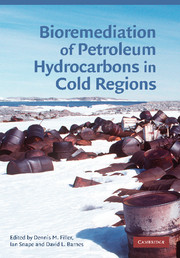Book contents
- Frontmatter
- Contents
- List of contributors
- Preface
- Glossary
- 1 Contamination, regulation, and remediation: an introduction to bioremediation of petroleum hydrocarbons in cold regions
- 2 Freezing and frozen soils
- 3 Movement of petroleum through freezing and frozen soils
- 4 Hydrocarbon-degrading bacteria in contaminated cold soils
- 5 Temperature effects on biodegradation of petroleum contaminants in cold soils
- 6 Analytical methods for petroleum in cold region soils
- 7 Treatability studies: microcosms, mesocosms, and field trials
- 8 Nutrient requirements for bioremediation
- 9 Landfarming
- 10 Thermally enhanced bioremediation and integrated systems
- 11 Emerging technologies
- References
- Index
11 - Emerging technologies
Published online by Cambridge University Press: 22 August 2009
- Frontmatter
- Contents
- List of contributors
- Preface
- Glossary
- 1 Contamination, regulation, and remediation: an introduction to bioremediation of petroleum hydrocarbons in cold regions
- 2 Freezing and frozen soils
- 3 Movement of petroleum through freezing and frozen soils
- 4 Hydrocarbon-degrading bacteria in contaminated cold soils
- 5 Temperature effects on biodegradation of petroleum contaminants in cold soils
- 6 Analytical methods for petroleum in cold region soils
- 7 Treatability studies: microcosms, mesocosms, and field trials
- 8 Nutrient requirements for bioremediation
- 9 Landfarming
- 10 Thermally enhanced bioremediation and integrated systems
- 11 Emerging technologies
- References
- Index
Summary
Introduction
In this book, current scientific knowledge and practical experiences with bioremediation of petroleum-contaminated soils in cold regions are reviewed and compiled. We now more fully understand the inter-relationships between cold temperatures, soil and water properties, and biological processes. This aids decision making about practical remediation treatment for petroleum-contaminated sites in cold regions. Landfarming and enhanced bioremediation schemes have emerged as viable soil treatment methods that offer a number of advantages over other methods. Nevertheless, work still needs to be done to optimize these methods, and with regards to evaluating phytoremediation and rhizosphere enhancement potentials for cold soils.
Two emerging technologies have been identified that could offer significant cost savings; low-cost heating and controlled-release nutrient systems are described briefly here (see also Chapter 8). In addition, natural attenuation has received little rigorous evaluation for use in cold soils. The main limitation for natural attenuation in cold regions is the low rate of degradation, coupled with off-site migration that can be relatively rapid in soils or gravel pads that have a poor adsorption capacity. Permeable reactive barriers are one groundwater treatment technology that could buy time for slower in situ techniques such as natural attenuation to take place. An outline of emerging permeable-reactive barrier technology is presented here, although full-scale trials are not yet complete. It is possible that such in situ techniques, when coupled with aeration, sparging and biostimulation could offer methods for groundwater treatment in cold regions.
- Type
- Chapter
- Information
- Bioremediation of Petroleum Hydrocarbons in Cold Regions , pp. 212 - 230Publisher: Cambridge University PressPrint publication year: 2008



